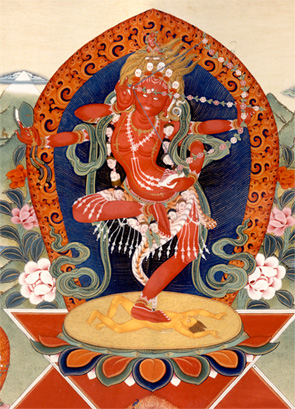Kurukulla: Difference between revisions
Jump to navigation
Jump to search
No edit summary |
No edit summary |
||
| Line 3: | Line 3: | ||
It should be noted that in her well known mantra, it says Kurukulle and not Kurukulla, yet this is because of the vocative form of Sanskrit grammar. The proper noun in Sanskrit is thus Kurukulla, although Tibetans call her Kurukulle. | It should be noted that in her well known mantra, it says Kurukulle and not Kurukulla, yet this is because of the vocative form of Sanskrit grammar. The proper noun in Sanskrit is thus Kurukulla, although Tibetans call her Kurukulle. | ||
==Empowerments Given to the [[About Rigpa|Rigpa]] Sangha== | |||
*[[Neten Chokling Rinpoche]], [[Lerab Ling]], 5 November 2013: essential Pema Khandro (Kurukulla) empowerment | |||
*Neten Chokling Rinpoche, Lerab Ling, 28 September 2014: Kurukulla empowerment | |||
*Neten Chokling Rinpoche, Lerab Ling, 28 July 2015: Kurukulla empowerment | |||
==Internal Links== | ==Internal Links== | ||
Revision as of 09:46, 7 June 2024

Kurukulla (Skt. kurukullā; Tib. རིག་བྱེད་མ་, Rikjéma, Wyl. rig byed ma) — a female deity of the Lotus family, associated with the activity of magnetization or enchantment. She is usually depicted as red in colour, in dancing posture and holding a flowery bow and arrow. She is also one of the Twenty-One Taras mentioned in the ancient Tara tantras.
It should be noted that in her well known mantra, it says Kurukulle and not Kurukulla, yet this is because of the vocative form of Sanskrit grammar. The proper noun in Sanskrit is thus Kurukulla, although Tibetans call her Kurukulle.
Empowerments Given to the Rigpa Sangha
- Neten Chokling Rinpoche, Lerab Ling, 5 November 2013: essential Pema Khandro (Kurukulla) empowerment
- Neten Chokling Rinpoche, Lerab Ling, 28 September 2014: Kurukulla empowerment
- Neten Chokling Rinpoche, Lerab Ling, 28 July 2015: Kurukulla empowerment